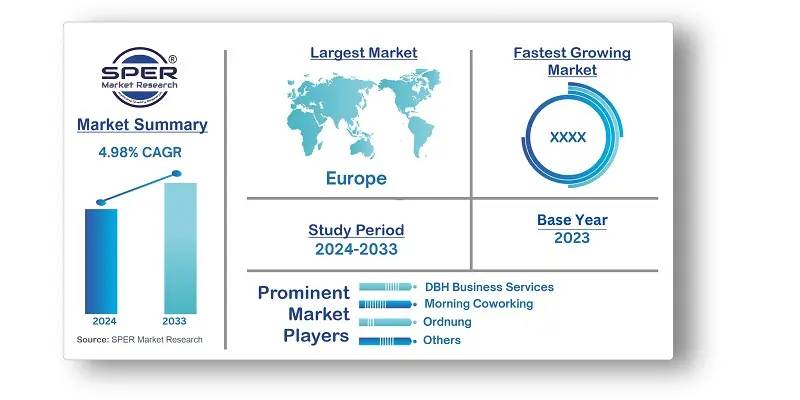
Europe Co-Working Space Market Trends, Share, Size, Demand, Revenue and Future Outlook
Europe Co-Working Space Market Growth, Size, Trends Analysis- By End Use, By User- Regional Outlook, Competitive Strategies and Segment Forecast to 2033
| Published: Nov-2024 | Report ID: FMCG24182 | Pages: 1 - 156 | Formats*: |
| Category : Consumer & Retail | |||
- In July 2024, Techspace, a coworking space operator located in the UK and Germany, will open a large 7.500 m2 space in London's Clerkenwell and prepare to open a new location in Munich. There will be enough for around 1,000 new members and 900 desks at the new facility.
- March 2024: Leading Central European investor Peter KorbaÄka has signed a management deal with infinitSpace, a tech-led provider of flexible workplaces, to open the company's first German presence in Berlin's brand-new Quartier Heidestrasse development.


| Report Metric | Details |
| Market size available for years | 2020-2033 |
| Base year considered | 2023 |
| Forecast period | 2024-2033 |
| Segments covered | By End Use, By User |
| Regions covered | France, Germany, Italy, Spain, United Kingdom, Rest of Europe |
| Companies Covered | DBH Business Services, Deworkacy, Klein Kantoor, Matrikel1, Morning Coworking, Ordnung, Regus/IWG, Scalehub, The Office Group, WeWork, Others |
- Freelancers and Independent Professionals
- Startups and Small Businesses
- Remote Workers and Digital Nomads
- Corporations and Enterprises
- Creative Agencies and Consultants
- Nonprofits and Community Organizations
- Educational Institutions and Students
- Events and Workshops Organizers
| By End Use: | |
| By User: | |
| By Region: |
- Europe Co-Working Space Market Size (FY’2024-FY’2033)
- Overview of Europe Co-Working Space Market
- Segmentation of Europe Co-Working Space Market By End Use {(Information Technology (IT and ITES), BFSI (Banking, Financial Services and Insurance), Business Consulting & Professional Services, Others}
- Segmentation of Europe Co-Working Space Market By User (Freelancers, Enterprises, Start Ups, Others)
- Expansion Analysis of Europe Co-Working Space Market
- Problems and Obstacles in Europe Co-Working Space Market
- Competitive Landscape in the Europe Co-Working Space Market
- Impact of COVID-19 and Demonetization on Europe Co-Working Space Market
- Details on Current Investment in Europe Co-Working Space Market
- Competitive Analysis of Europe Co-Working Space Market
- Prominent Players in the Europe Co-Working Space Market
- SWOT Analysis of Europe Co-Working Space Market
- Europe Co-Working Space Market Future Outlook and Projections (FY’2024-FY’2033)
- Recommendations from Analyst
1.1. Scope of the report1.2. Market segment analysis
2.1. Research data source
2.1.1. Secondary Data2.1.2. Primary Data2.1.3. SPER’s internal database2.1.4. Premium insight from KOL’s
2.2. Market size estimation
2.2.1. Top-down and Bottom-up approach
2.3. Data triangulation
4.1. Driver, Restraint, Opportunity and Challenges analysis
4.1.1. Drivers4.1.2. Restraints4.1.3. Opportunities4.1.4. Challenges
4.2. COVID-19 Impacts of the Europe Co-Working Space Market
5.1. SWOT Analysis
5.1.1. Strengths5.1.2. Weaknesses5.1.3. Opportunities5.1.4. Threats
5.2. PESTEL Analysis
5.2.1. Political Landscape5.2.2. Economic Landscape5.2.3. Social Landscape5.2.4. Technological Landscape5.2.5. Environmental Landscape5.2.6. Legal Landscape
5.3. PORTER’s Five Forces
5.3.1. Bargaining power of suppliers5.3.2. Bargaining power of buyers5.3.3. Threat of Substitute5.3.4. Threat of new entrant5.3.5. Competitive rivalry
5.4. Heat Map Analysis
6.1. Europe Co-Working Space Market Manufacturing Base Distribution, Sales Area, Product Type6.2. Mergers & Acquisitions, Partnerships, Product Launch, and Collaboration in Europe Co-Working Space Market
7.1. Europe Co-Working Space Market Size, Share and Forecast, By End Use, 2020-20267.2. Europe Co-Working Space Market Size, Share and Forecast, By End Use, 2027-20337.3. Information Technology (IT and ITES)7.4. BFSI (Banking, Financial Services and Insurance)7.5. Business Consulting & Professional Services7.6. Others
8.1. Europe Co-Working Space Market Size, Share and Forecast, By User, 2020-20268.2. Europe Co-Working Space Market Size, Share and Forecast, By User, 2027-20338.3. Freelancers8.4. Enterprises8.5. Start Ups8.6. Others
9.1. Europe Co-Working Space Market Size and Market Share
10.1. Europe Co-Working Space Market Size and Market Share By Region (2020-2026)10.2. Europe Co-Working Space Market Size and Market Share By Region (2027-2033)10.3. France10.4. Germany10.5. Italy10.6. Spain10.7. United Kingdom10.8. Rest of Europe
11.1. DBH Business Services
11.1.1. Company details11.1.2. Financial outlook11.1.3. Product summary11.1.4. Recent developments
11.2. Deworkacy
11.2.1. Company details11.2.2. Financial outlook11.2.3. Product summary11.2.4. Recent developments
11.3. Klein Kantoor
11.3.1. Company details11.3.2. Financial outlook11.3.3. Product summary11.3.4. Recent developments
11.4. Matrikel1
11.4.1. Company details11.4.2. Financial outlook11.4.3. Product summary11.4.4. Recent developments
11.5. Morning Coworking
11.5.1. Company details11.5.2. Financial outlook11.5.3. Product summary11.5.4. Recent developments
11.6. Ordnung
11.6.1. Company details11.6.2. Financial outlook11.6.3. Product summary11.6.4. Recent developments
11.7. Regus/ IWG
11.7.1. Company details11.7.2. Financial outlook11.7.3. Product summary11.7.4. Recent developments
11.8. Scalehub
11.8.1. Company details11.8.2. Financial outlook11.8.3. Product summary11.8.4. Recent developments
11.9. The Office Group
11.9.1. Company details11.9.2. Financial outlook11.9.3. Product summary11.9.4. Recent developments
11.10. WeWork
11.10.1. Company details11.10.2. Financial outlook11.10.3. Product summary11.10.4. Recent developments
11.11. Others
SPER Market Research’s methodology uses great emphasis on primary research to ensure that the market intelligence insights are up to date, reliable and accurate. Primary interviews are done with players involved in each phase of a supply chain to analyze the market forecasting. The secondary research method is used to help you fully understand how the future markets and the spending patterns look likes.
The report is based on in-depth qualitative and quantitative analysis of the Product Market. The quantitative analysis involves the application of various projection and sampling techniques. The qualitative analysis involves primary interviews, surveys, and vendor briefings. The data gathered as a result of these processes are validated through experts opinion. Our research methodology entails an ideal mixture of primary and secondary initiatives.



Frequently Asked Questions About This Report
PLACE AN ORDER
Year End Discount
Sample Report
Pre-Purchase Inquiry
NEED CUSTOMIZATION?
Request CustomizationCALL OR EMAIL US
100% Secure Payment






Related Reports
Our Global Clients
Our data-driven insights have influenced the strategy of 200+ reputed companies across the globe.




















